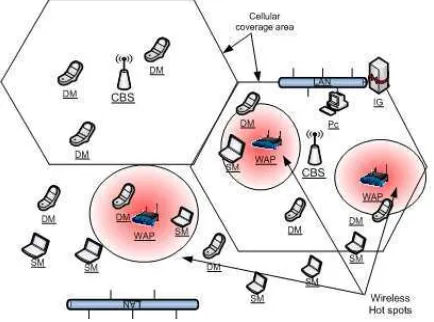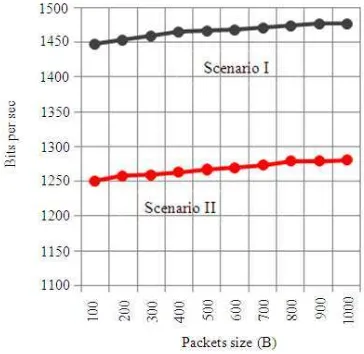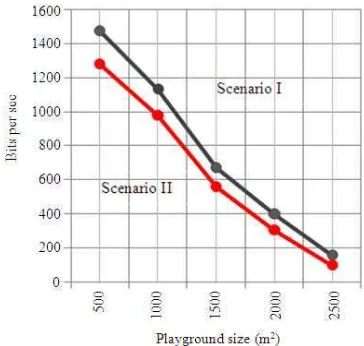ISSN 1549-3636
© 2010 Science Publications
Corresponding Author: Zahian Ismail, Department of Computer Science, Faculty of Information Science and Technology, University Kebangsaan Malaysia, 43600 UKM Bangi, Selangor, Malaysia
Evaluation of Ad Hoc on Demand Distance Vector
Routing
Protocol in HetMAN Architecture
Zahian Ismail and Rosilah Hassan
Department of Computer Science, Faculty of Information Science and Technology,
University Kebangsaan Malaysia, 43600 UKM Bangi, Selangor, Malaysia
Abstract:Problem statement: Mobile Ad hoc Network (MANET), a type of network with special characteristics, needs a special mechanism to bear with its ad hoc behavior. Approach: The important issue in MANET is routing protocol. Routing protocol is a standard used to determine the route path taken during the transmission of data. Results: In this study we focused on the Ad hoc On demand Distance Vector (AODV) routing protocol for MANET. Simulation experiments were carried out using the OMNeT++ network simulator to study AODV performance in a HetMAN architecture, which models heterogeneous MANET that is MANET integrated with Internet through fixed and wireless networks. The four types of network in HetMAN architecture are MANET, wireless LAN, wired LAN and cellular network. The simulation results were analyzed using several metrics assigned to measure the routing protocol performance. Conclusion/Recommendations: We described three scenarios for HetMAN architecture. This study covered scenario I (communication entirely within MANET; Homogeneous MANET) and scenario II (communication between MANET and wireless LAN; Heterogeneous MANET). Analyzing the simulation results for these two scenarios, we compared the performance of AODV in homogeneous MANET and heterogeneous MANET. Throughput value for scenario I was found to be 16% higher than for scenario II, while packet delivery ratio in scenario I is between 26.5-36.6% higher than that for scenario II. Analysis showed that implementation of AODV performed better in homogeneous MANET than in heterogeneous MANET.
Key words: MANET, heterogeneous MANET architecture, OMNeT++, performance analysis
INTRODUCTION
MANET is a group of wireless computing devices like laptop, mobile phone, Personal Digital Assistant (PDA), or similar devices which can communicate directly with one another without a central coordinator. A MANET is an autonomous system of mobile routers and associated hosts connected by wireless links. It does not require a fixed network infrastructure due to its wireless nature and can be deployed as a multi hop packet network both rapidly and with low expense (Ismail et al., 2009). MANET has its own routing protocols which can compromise frequent route exchange, dynamic topology, bandwidth constraint and multi hop routing. An ad hoc routing protocol is a convention, or standard, that controls how nodes decide which way to route packets between computing devices in a mobile ad hoc network (Mittal and Kaur, 2009).
The routing protocols that are available for MANET comprise proactive (table driven), reactive (on demand) and hybrid routing protocols. Popular
proactive routing protocols are highly dynamic Destination-Sequenced Distance Vector (DSDV) and Optimized Link State Routing protocol (OLSR) while reactive routing protocols include Ad hoc On demand Distance Vector (AODV) and Dynamic Source Routing (DSR). An example of a hybrid routing protocol is Zone Routing Protocol (ZRP). AODV meets the MANET requirements for dynamic, self-starting, multi hop routing between participating mobile nodes wishing to establish and maintain an ad hoc network (Royer and Perkins, 2000).
According to Hashmi and Brooke (2008), there are two types of MANET according to the way they deal with other networks: Closed (or homogeneous) MANET and open (or heterogeneous) MANET. Homogeneous MANET closes communication to other networks and limits communication within the network. Heterogeneous MANET, on the other hand, enables communication between MANET and other types of wireless or wired networks (Hassan et al., 2008).
In this research, we simulated the implementation of AODV routing protocols in both closed and open MANET networks. Network simulation is used to predict expanded network performance. It is important to know the current status of network performance before migrating or expanding the network (Sailan and Hassan, 2009a). Furthermore, not only does simulation cost less than conducting a real implementation, but it also can analyze and verify theoretical models which may be too difficult to grasp from a purely conceptual level. For this project we used OMNeT++ version 4.0 with the inetmanet frameworks since its functions are very good for testing the AODV routing protocol.
In previous work, we developed what we call HetMAN architecture, that is, the architecture of heterogeneous MANET. Figure 1 depicts this architecture. Managing heterogeneous network systems is a difficult task because each one has its own peculiar management system (Hassan et al., 2009a). These networks usually are constructed on independent management protocols which are not compatible with each other (Hassan et al., 2009b). The architecture shows how MANET is connected to wireless and wired networks.
Fig. 1: HetMAN network architecture. CMS: Cellular Mobile Station; LAN: Local Area Network infrastructure; WAP: Wireless Access Point; DM: Dual Mode node; SM: Single Mode node; IG: Internet Gateway
Nodes in MANET communicate with cellular networks through a cellular base station and communicate with wireless networks through a wireless access point. MANET also can communicate with a wired network through infrastructure-based LAN.
HetMAN is a network formed by a group of freely mobile self-organized devices. This network allows for two types of device connectivity. The first type includes single hop connectivity, with connection under the coverage of Wireless Access Point (WAP) hotspots or Cellular Mobile Stations (CMS). Two WAPs with a range of 100 m are attached to the IP network through the LAN infrastructure. The base station in its turn is connected to another central base station. All the nodes that are in the range of CMS or WAP can gain access to the external Internet by a single wireless hop. The second type connectivity is a multi hop connection. Any other nodes outside the CMS or WAP range are connected by a multi hop operation. Based on this architecture, we have devised three scenarios:
• Scenario I: Nodes communication within MANET
• Scenario II: Nodes communication between MANET and wireless network
• Scenario III: Nodes communication between MANET and wired network
We have simulated the first two scenarios with OMNeT++ implementing AODV. In this study, we will focus on performance of the AODV routing protocol within these two scenarios. The performance evaluation metrics are throughput and Packet Delivery Ratio (PDR).
MATERIALSANDMETHODS
Simulation environment: In this OMNeT++ simulation, Network Description (NED) files stored the relationship between modules and the communication links, which can be modeled graphically.
The files written in C++ represented behavior of the scenarios. The .ini file tells the simulator which network to simulate and holds the parameter settings of the simulation. Simulation can be run in a graphical environment or in command line applications.
communication between nodes within MANET. In this simulation, the focus is the communication among the nodes within MANET. Each device in MANET is free to move and independently change its location, so the links to other devices change frequently. MANET devices are connected by wireless link. In HetMAN architecture, several nodes are out of WAP range. Each node communicates with the others by multi hop wireless transmission. (Note that there is no WAP coverage since this scenario represents homogeneous MANET). The node will communicate with the nearest node to them which become the intermediate node to target node. The nodes in HetMAN consist of laptops and cellular phones but in this simulation we only use laptops as the nodes.
Simulation of scenario II: Nodes communication between MANET and wireless network: Nodes in operations. WLAN uses the interface to communicate with MANET. The gateway interface in MANET enables nodes in MANET to access nodes in WLAN. Cellular network enhances the performance of MANET since it can control the operation of MANET by providing authentication, routing and security.
Each node in MANET has a unique address. It is meaningful only inside the ad hoc network since there is no external connectivity. In HetMAN architecture, there is a solution which provides Internet access for ad hoc nodes. One or more of the nodes must have at least two network interfaces. One part is ad hoc nodes and other part as gateway. The nodes become a gateway and provide Internet access for the wireless nodes only. The gateway manages certain address spaces and each ad hoc node needs to acquire the address in order to communicate through the gateway. The data packets will be enforced to ad hoc nodes from the Internet via the gateway. If multiple gateways exist, ad hoc nodes decide which gateway to choose. Each gateway is independent of all others and manages different address spaces.
Simulation setup: The simulation was performed using a setup that determines the parameters of the simulation, for example, the number of nodes and the routing protocol and mobility types. The parameters chosen are those used in previous similar work. Table 1 summarizes the parameters of the setup.
Tale1: Parameters setup
Parameter Value
Simulation parameters
Numer of nodes 5,7
Simulation time 3000s
Playground size 500×500, 1000×1000, 1500×1500, 2000×2000 and 2500×2500 m
Routing and MAC protocol
Routing protocol AODV
MAC protocol 802.11 g
Mobility pattern
Mobility types Random waypoint mobility
Speed 2 Mps
Mobility wait time 0.1 sec
Ma × hop limit 10 number of statistics. The performance metrics chosen for this simulation are as follows:
• Throughput-the average rate of successful message delivery over a communication channel. This data may be delivered over a physical or logical link, or pass through a certain network node. Throughput = total number of packets received by the destination node. Throughput is measured in bits per second (bps)
Fig. 2: The nodes in MANET simulation
Fig. 3: The nodes in MANET_WLAN simulation
RESULTS
After completing the simulations of scenario I and scenario II, we analyzed the performance of the AODV for each of the chosen metrics. The results are shown in Fig. 4-7.
Throughput, the main performance metrics for the test scenario (Sailan and Hassan, 2009b), is a measure of the effectiveness of the routing protocol.
Fig. 4: Throughput for simulation I and simulation II in 500 m2 playground size
Fig. 5: PDR for simulation I and simulation II in 500 m2 playground size
Figure 4 shows the influence of the packet size on network throughput for scenario I and for scenario II. The throughput value increased with increasing packet size for both scenarios. The maximum throughput gain was found for the simulation with packet size of 1000 Bytes and the minimum throughput gain was found for the simulation with packet size of 100 Bytes. The increase in packet size allows more data per packet to be sent. Scenario I was found to have 16% higher throughput than scenario II.
from 100-800 Bytes and then decreased from 900 Bytes and above. For scenario II, PDR value increased from 100-800 Bytes and decreased at 900 Bytes, but the value increased again at 1000 Bytes. A large packet size keeps the transport layer channel busy and was seen to affect the value of PDR. We set the fixed simulation time at 3000 sec, but with larger packet size the nodes need more time to transmit the data, accounting for the decrease in PDR after 800 Bytes. The PDR of scenario I was between 26.5-36.6% higher than the PDR for scenario II. In addition, according to Li and Singhal (2005), for AODV routing protocol, the network size exerts a significant influence. Scenario I has 5 nodes and scenario II has 7 nodes. When the network size increases (from the 5 nodes of scenario I to the 7 nodes of scenario II), the PDR decreases.
Fig. 6: Throughput for simulation I and simulation II in 800 Bytes packet size
Fig. 7: PDR for simulation I and simulation II in 800 Bytes packet size
Figure 6 denotes throughput over playground size (simulation area) for scenario I and scenario II. We set the simulation with a fixed packet size and varied the size of the simulation area. 800 Bytes is the optimal packet size for this experiment. We set the playground size at 500×500, 1000×1000, 1500×1500, 2000×2000 and 2500×2500 m. The result showed that for both scenarios throughput decreased while the simulation area increased. In MANET, the nodes perform a multi hop operation to transmit data. The size of simulation area affected the number of hops perform by nodes. A very large simulation area causes the nodes to perform many hops. Thus, an increase in number of hops resulted in lower throughput.
In the simulation, the playground size determines the maximum number of hops required. Figure 7 shows PDR over playground size for scenario I and for scenario II. Similar to the results shown in Fig. 6, PDR was found to decrease as the simulation area increased due to the increase in number of multi hop operations in the simulation. Multi hop operations cause the packets to queue before arrival at their destination. The packets which perform multi hop operations will be in queue longer than those in the single hop operations. In multi hop operations, the source nodes send the packets to the intermediate nodes first to be passed to the destination nodes. If it takes so many intermediate nodes to pass the packets, the number of hops will increase. Literally, it requires longer for the packets to arrive.
DISCUSSION
Scenario I represents homogeneous MANET, consisting of nodes within the same network with a similar configuration setup while scenario II, representing heterogeneous MANET, consists of various networks with a different configuration setup and different capabilities in sending and receiving data packets. This difference in complexity explains the better performance in homogeneous MANET than in heterogeneous MANET.
Given the HetMAN architecture, we have defined three scenarios based on the architecture. We have already implemented the first two scenarios, as reported in this study. Our future study will be to simulate scenario III, modeling the communication between MANET and a fixed network, therefore another heterogeneous MANET.
between MANET and fixed LAN. Given the architecture and network scenarios above, in our forthcoming study, we plan to endeavor to use the same simulation to assess the implementation of the third scenario. We will evaluate the network performance using the same metrics as for scenario I and scenario II.
CONCLUSION
In this study, we report the results of the network simulation which implements AODV routing protocol as implemented in a homogeneous MANET network (scenario I) and in a heterogeneous MANET network with wireless (scenario II) derived from HetMAN architecture.
In this simulation, packet sizes were found to have a large impact on throughput in wireless environment as well as on PDR. The result shows that as packet size increased, throughput and PDR also increased. The size of the simulation playground was found to determine the maximum number of hops performed by nodes. As the playground size increased, the number of hops also increased. This increase in area size leads to the decreasing value of both throughput and PDR. We conclude that implementing AODV led to a good result in this simulation, especially for the scenario with homogeneous MANET.
Overall, the throughput and PDR value are good for both scenarios. Scenario I gained 16% higher throughput than scenario II and its PDR was between 26.5-36.6% higher than that for scenario II. It can also be concluded that homogeneous MANET performs better than heterogeneous MANET. These tests prove that the current AODV routing protocol is less adaptable in a wireless heterogeneous MANET environment. Studies of the performance of the AODV routing protocol can lead to the development of an optimal enhanced AODV protocol which can maximize routing performance, particularly in heterogeneous networks and overcome the limitation of the existing AODV protocol.
ACKNOWLEDGMENT
This researcher is funded by University Kebangsaan Malaysia (UKM) Research Project UKM-GUP-NBT-08-29-116 and was carried out by the Network Management Group. Please visit our website at http://www.ftsm.ukm.my/network. Special thanks go to Mr. Zulkiflee Kusin for his valuable guidance in OMNeT++. The authors thank Pn. Alena Lee Sanusi for useful editorial comments on the manuscript.
REFERENCES
Das, S. R. C.E. Perkins, E.M. Royer and M.K. Marina, 2001. Performance comparison of two on-demand routing protocols for ad hoc networks. Proceeding of the IEEE Personal Communications Magazine Special Issue on Ad hoc Networking, Feb. 2001, pp: 16-28. DOI: 10.1.1.102.1879
Harri, J., F. Filali and C. Bonnet, 2007. On meaningful parameters for routing in VANETs urban environments under realistic mobility patterns. Proceeding of the Eurecomm Seminar Series 2007, Jan. 18, Sophia-Antipolis, France, pp: 1-10. International Conference on Emerging Security Information, Systems and Technologies, Aug. 25-31, ACM Press, Cap Esterel, France, pp: 120-126. http://www.computer.org/portal/web/csdl/doi/10.11 09/securware.2008.68
Hassan, R., J. Irvine and I. Glover, 2008. Design and analysis of virtual bus transport using synchronous digital hierarchy/synchronous optical networking. J. Comput. Sci., 4: 1003-1011. http://www.scipub.org/scipub/ab_issue.php?pg_no =10031011&j_id=jcs&art_no=510&issue_no41 Hassan, R., A. Patel, R. Razali, O. Mohamad, Z. Ismail
and S. Mohseni, 2009a. Design of network management tool architecture for heterogeneous system. Proceeding of the International Engineering Convention, May 11-13, Damascus,
Syria, pp: 60-67.
http://eng.upm.edu.my/~feiic/intec2009/ICEE-ELECTRICAL.pdf
Hassan, R., R. Razali, S. Mohseni, O. Mohamad and Z. Ismail, 2009b. Architecture of network management tools for heterogeneous system. Int. J. Comput. Sci. Inform. Secur., 6: 31-40. http://www.docstoc.com/docs/22369599/Internatio nal-Journal-of-Computer-Science
Li, H. and M. Singhal, 2005. A scalable routing protocol for ad hoc networks. Proceeding of Vehicular Technology Conference, May 30-June 1, IEEE Computer Society, Stoclhom, Sweden,
pp: 2498-2503. DOI:
10.1109/VETECS.2005.1543785
Mittal, S. and P. Kaur, 2009. Performance comparison of AODV, DSR and ZRP routing protocols in MANET’s. Proceeding of the 2009 International Conference on Advances in Computing, Control and Telecommunication Technologies, Dec. 28-29, Trivandrum, Kerala, India, pp. 165-168. http://www.computer.org/portal/web/csdl/doi/10.11 09/ACT.2009.50
Royer, E.M. and C.E. Perkins, 2000. An implementaion study of AODV routing protocol. Proceeding of the IEEE Wireless Communications and Networking Conference, Sept. 23-28, Chicago, pp: 1003-1008. Sailan, M.K. and R. Hassan, 2009a. Design of accurate end-to-end IPv4 and IPv6 performance test. Proceeding of the 5th National Conference on Programming Science, Dec. 10-10, Putrajaya, Malaysia. http://www.ftsm.ukm.my/atur09/ Sailan, M.K. and R. Hassan, 2009b. Impact of TCP


